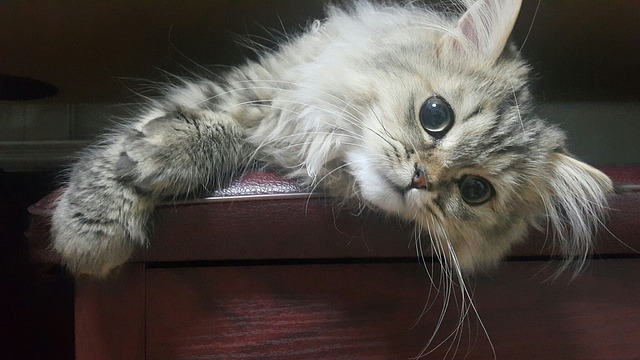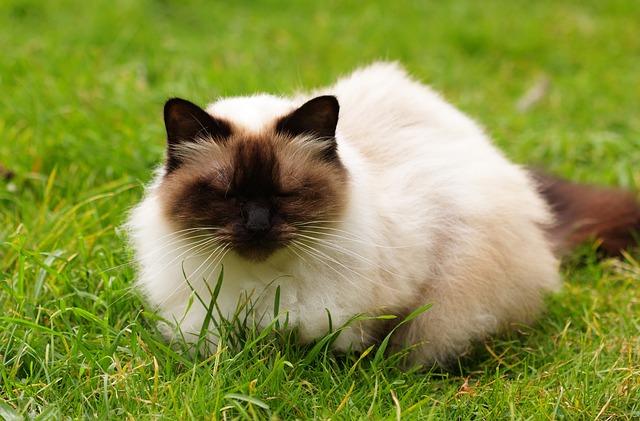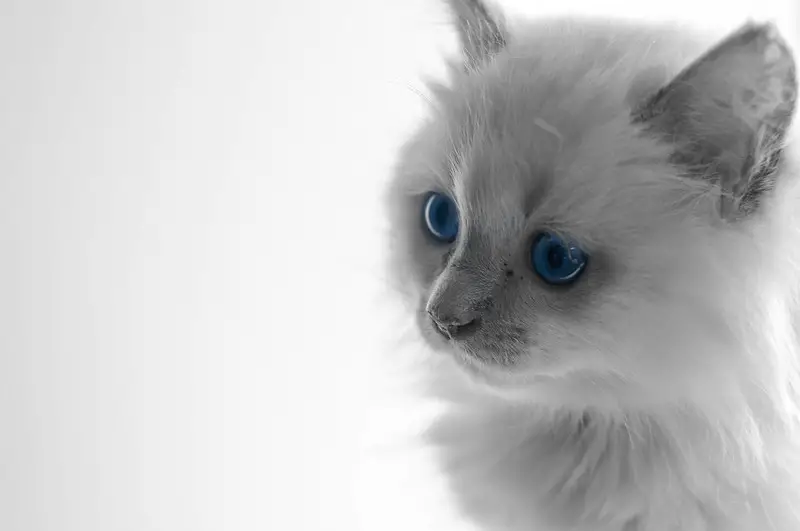The Persian cat has a long history dating back to ancient Persia, the Himalayan is a relatively new breed that emerged in the 20th century. In terms of their physical characteristics, Persian cats have a rounder face and a thicker coat than their Himalayan counterparts. They also tend to be more laid-back and affectionate than Himalayans who are more active and playful.
History of the Persian Cat
(Image by SUA SON from Pixabay )

The Persian cat has a long and fascinating history that dates back to ancient times. These regal felines were first discovered in the highlands of Iran, where they were bred for their luxurious fur and elegant appearance.
During the 16th century, Italian traders brought these cats to Europe, where they became popular with aristocrats and royalty. Over time, breeders developed different variations of the Persian cat, including the flat-faced or “doll-faced” variety.
In the early 1900s, Persians cats were introduced to America and quickly gained popularity as house pets. Today, this breed is one of the most beloved around the world thanks to its gentle nature and striking beauty.
Despite their royal origins and glamorous reputation today, Persians have humble beginnings as rodent hunters in Iranian villages. It’s amazing how far they’ve come!
History of the Himalayan Cat
(Image by No-longer-here from Pixabay )

The Himalayan cat, also known as the “Himmy,” is a breed that originated in the United States during the 1930s. It was developed by crossing Persians with Siamese cats to create a cat breed that had the Persian’s long hair and body type while having Siamese color points.
The first breeder of Himalayan cats was Marguerita Goforth of Newton Cattery in California, who produced the first litter of these beautiful felines in 1931. She then continued to experiment with breeding and crossbreeding until she perfected this new breed.
In 1957, The Cat Fanciers Association (CFA) recognized Himalayans as a separate breed apart from Persians and Siamese. Since then, they have become one of the most popular breeds in America due to their striking beauty and affectionate personality.
Interestingly enough, although they are named after the mountain range between India and Tibet called “The Himalayas”, there is no evidence that this breed has any connection to this region or its native cat population.
While not an ancient or exotic form of feline species like other breeds we know today, it’s impressive how such an iconic cat can be created through experimentation with different genes over time.
Physical Characteristics of Persian Cats
Persian cats are a popular breed known for their luxurious and fluffy coat. Their body structure is sturdy, with short legs and a round head. The most distinctive feature of Persian cats is their flat face, which gives them an adorable expression but also causes some health issues.
Their beautiful long hair requires daily grooming to prevent matting and tangling. Persians have a wide range of coat colors and patterns, including solid white, black, silver, cream, smoke, shaded or tipped varieties.
Persians have large eyes that are typically blue or green in color. They have a broad nose and small ears that are set low on the head. Their bodies are generally stocky with strong bones and muscular necks.
Due to their unique features such as the flat face shape (brachycephalic), they may develop respiratory problems or tear duct issues if not given proper care.
Persian cats make excellent indoor pets due to their calm nature and affectionate personality. However, potential owners should be aware of their high maintenance needs when it comes to grooming and healthcare requirements before adopting one into their home.
Physical Characteristics of Himalayan Cats
Himalayan cats are known for their distinctive looks, which come from both their Persian and Siamese ancestors. These cats have a medium-sized body with long, silky fur that is soft to the touch. The Himalayan’s coat comes in a wide range of colors, including cream, blue, chocolate, lilac and seal point.
One of the most notable physical characteristics of this breed is their pointed ears and large round eyes that can be either blue or deep copper in color. Their nose is also short and broad with an upward tilt towards their forehead.
The Himalayan cat has a stocky build with well-rounded features such as full cheeks and rounded paws. They have sturdy legs that end in small tufts of fur on the tips of each toe making them look like they’re wearing little boots.
Their tail is plushy and bushy giving off a luxurious appearance while adding to their overall balance when standing or moving around gracefully. Overall these gorgeous felines present themselves as elegant creatures with striking beauty unmatched by any other feline breed out there!
Personality Differences Between Persian and Himalayan Cats
Persians are known to be calm, quiet, and affectionate companions who love to spend time lounging with their owners. On the other hand, Himalayan cats tend to be more outgoing and playful.
Persian cats can be shy around strangers but once they get comfortable in their environment they become very loyal to their owners. They enjoy being pampered and petted while sitting on a lap or next to their owner watching TV. Persian cats also prefer a predictable routine so as not to feel startled by any sudden changes.
Himalayan cats are social animals who crave attention from humans and other felines alike. They show an unusual interest in playing games like fetch or hide-and-seek with toys or even small objects found around the house. This makes them great pets for children as well as adults since they can easily adapt themselves according to different personalities.
Both breeds have unique qualities that make them lovable pets. While Persian Cats tend towards being quieter companions suited for indoor environments; Himalayans have an outgoing nature making them perfect for families looking for active playmates!
Persian cats Vs. Himalayan cats – Key differences
When it comes to comparing Persian and Himalayan cats, there are a few key differences that set them apart. The most notable difference is their physical appearance. While they may look similar at first glance, there are some distinct features that differentiate the two breeds.
Firstly, Persian cats have a rounder face with a shorter muzzle and smaller ears compared to the Himalayan cat’s slightly flatter face with larger ears. Additionally, Persian cats tend to have longer hair than their Himalayan counterparts.
Another significant difference between these two breeds is their personality traits. Persian cats are known for being laid back and affectionate while Himalayan cats can be more energetic and playful.
When it comes to health concerns, both breeds are prone to certain issues such as eye problems and breathing difficulties due to their facial structure. However, Persians are also susceptible to kidney disease while Himalayans may experience dental issues.
Whether you choose a Persian or Himalayan cat depends on your personal preferences in terms of appearance and personality traits. It’s important to do your research and consult with a reputable breeder before making any decisions on which breed would be best suited for you and your lifestyle.
How to care for Persian cats and Himalayan cats?
Taking care of Persian and Himalayan cats may seem overwhelming at first, but it is not as difficult as you might think. Here are some tips on how to keep your feline friends healthy and happy.
Firstly, both breeds require regular grooming due to their long fur. Brushing them daily will help prevent matting and hairballs. Additionally, make sure to trim their nails regularly to avoid discomfort or damage to furniture.
Secondly, provide a balanced diet that meets their nutritional needs. Consult with your veterinarian for recommended brands or types of food suitable for your cat’s age and health status.
Thirdly, ensure they have access to clean drinking water at all times. Invest in a high-quality water bowl or fountain that encourages them to drink more fluids.
Create an environment that stimulates them mentally and physically. Provide toys like scratching posts or interactive playthings while keeping dangerous items out of reach.
By following these simple guidelines, you can enjoy many happy years with your fluffy companions!
Featured Image By – Michael Martin on Flickr








